|
|
 |
|
Calanoida ( Order ) |
|
|
|
Eucalanoidea ( Superfamily ) |
|
|
|
Eucalanidae ( Family ) |
|
|
|
Pareucalanus ( Genus ) |
|
|
| |
Pareucalanus sewelli (Fleminger, 1973) (F,M) | |
| | | | | | | Syn.: | Eucalanus sewelli Fleminger, 1973 (p.978, 992, 998, figs.F,M, fig.17); Deevey & Brooks, 1977 (p.256, tab.2, Station "S"); Björnberg & al., 1981 (p.619, figs.F,M, Rem.); Brodsky al., 1983 (p.210, figs.F,M); Van der Spoel & Heyman, 1983 (p.42, fig.54); Cummings, 1984 (p.163, Table 2); Tremblay & Anderson, 1984 (p.5: Rem.); Brinton & al., 1986 (p.228, Table 1); Suarez & Gasca, 1991 (tab.2); Barange & al., 1998 (p.1663, Table 2, abundance vs STC region); Muelbert & al., 2008 (p.1662, Table 1); Medellin-Mora & Navas S., 2010 (p.265, Tab. 2);
Eucalanus attenuatus : Sewell, 1912 (? part., p.353, 357); ? Rose, 1925 (p.151); Vervoort, 1946 (part., p.95, fig.7 d-f); Sewell, 1947 (part., p.39, fig.7A); Brodsky, 1962 c (p.113, figs.F); ? Ganapati & Shanthakumari, 1962 (p.7, 15); ? Björnberg, 1963 (p.19, Rem.); Duran, 1963 (p.13); ? Ramirez, 1969 (p.44, figs.F); ? Corral Estrada, 1970 (p.73, figs.F,M); ? Apostolopoulou, 1972 (p.327, 333); Carter, 1977 (1978) (p.35); Madhupratap & Haridas, 1986 (p.105, tab.1); Suarez & al., 1990 (tab.2); Suarez, 1992 (App.1); Suarez-Morales & Gasca, 1997 (p.1525); Padmavati & al., 1998 (p.347); Lavaniegos & Gonzalez-Navarro, 1999 (p.239, Appx.1); Neumann-Leitao & al., 1999 (p.153, tab.2); ? Lapernat & Razouls, 2002 (p.17, fig. Md); ? Berasategui & al., 2006 (p.485: fig.2);
? Eucalanus pseudattenuatus : Zheng & al., 1982 (p.13, figs.F,M); ); Zuo & al., 2006 (p.1159, tab.1, abundance, fig.8: stations group); Rakhesh & al., 2006 (p.93, Table 2, spatial distribution); Rakhesh & al., 2008 (p.154, abundance vs stations); W.-B. Chang & al., 2010 (p.735, Table 2, abundance); Guo & al., 2011 (p.567, table 2, indicator);
Paraeucalanus sewelli : ; Dias & Araujo, 2006 (p.45, Rem., chart) | | | | Ref.: | | | Bradford-Grieve, 1994 (p.82, figs.F,M, fig. 100), Rem.; Bradford-Grieve & al., 1999 (p.878, 912, figs.F,M); Lapernat, 1999 (p.15, 55, Rem.); 2000 (tabl.3, 4); Goetze, 2003 (p.2322 & suiv.); Mulyadi, 2004 (p.116, figs.F, Rem.); Prusova, 2007 (p.64, tab.1: integumental perforation pattern); Goetze & Ohman, 2010 (p.2110, Table 1, A1, Fig.12, Table A1, molecular study, biogeography) | 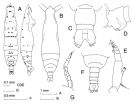 issued from : J.M. Bradford-Grieve in The Marine Fauna of New Zealand: Pelagic Calanoid Copepoda. National Institute of Water and Atmospheric Research (NIWA). New Zealand Oceanographic Institute Memoir, 102, 1994. [p.83, Fig.44]. Female (from Fleminger, p.991, Fig.15 c. As Eucalanus sewelli: A, habitus (dorsal and lateral pattern of integumental organs (black point = sites occuring at 100% frequency, o = 80-99% frequency, x = 10-79% frequency, triangle are sites which are also visible in lateral view but which are assigned to dorsal sets). Female (from Southwest Pacific): B, habitus (dorsal); C, urosome (dorsal); D, idem (lateral left side); E, Md (mandibular palp). Male (from Fleminger, 1973, p.994, Fig.18 p. As Eucalanus sewelli, redrawn by Bradford-Grieve): F, urosome (dorsal); G, P5.
|
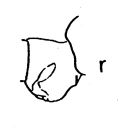 issued from : A. Fleminger in Fishery Bull. natn. Ocean. Atmos. Adm., 1973, 71 (4). [p.968, Fig.1, r (p.969)]. As Eucalanus sewelli. Female: r, genital segment (lateral right side).
|
 issued from : A. Fleminger in Fishery Bull. natn. Ocean. Atmos. Adm., 1973, 71 (4). [p.994, Fig.18]. As Eucalanus sewelli. Male: i, 4th-5th thoracic segments and urosome (dorsal); o, P5 (right lateral view); r, urosome and P5 (lateral right side). i, o, from specimen from 25°20'N, 112°45'W; r, specimen from 26°00N, 87°32'W
|
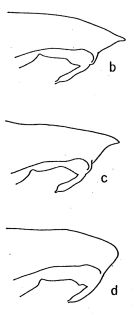 issued from : A. Fleminger in Fishery Bull. natn. Ocean. Atmos. Adm., 1973, 71 (4). [p.994, Fig.18, b-d]. As Eucalanus sewelli. Female: b, c, d, forehead (lateral right side). b, specimen from 26°00N, 87°32'W (Gulf or Mexico) c, from 09°11'S, 115°33'E (S Pacific). d, from 25°20'N, 112°45'W (off Baja California).
|
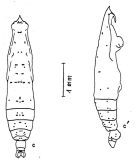 issued from : A. Fleminger in Fishery Bull. natn. Ocean. Atmos. Adm., 1973, 71 (4). [p.991, Fig.15 Ac, Bc]. As Eucalanus sewelli. Female: a, habitus (dorsal); a', idem (lateral right side). Dots represent sites occuring at a frequency of 100% in the pooled sample of the species, open circles are sites appearing in 80 to 99%, crosses are sites occupied in from 10 to 79%. Open triangles are sites also visible in lateral view but assigned to tergal sets. Nota: Forehead more strongly attenuated and longer than that in P. attenuatus, apex usually curving weakly ventral
|
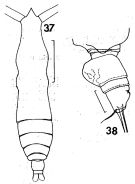 issued from : F.C. Ramirez in Contr. Inst. Biol. mar., Buenos Aires, 1969, 98. [p.42, Lam. VI, figs.37, 38]. As Eucalanus attenuatus. With doubt. Female (from off Mar del Plata): 37, habitus (dorsal); 38, urosome (lateral left side). Scale bars in mm: 1 (37); 0.2 (38).
|
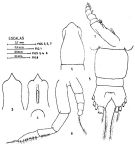 issued from : J. Corral Estrada in Tesis Doct., Univ. Madrid, A-129, Sec. Biologicas, 1970. [Lam.7, figs.3-8]. As Eucalanus attenuatus. With doubt. Female (from Canarias Is.): 3, forehead (dorsal); 4, idem (ventralà; 5, urosome (dorsal). Male: 6, head (dorsal); 7, Md (mandibular palp); 8, P5.
|
 issued from : R.B.S. Sewell in The John Murray Expedition, 1933-34, Scientific Reports, VIII (1), 1947. [p.39, Fig.7, A]. As Eucalanus attenuatus. Female (from Arabian Sea): B, habitus (dorsal).
|
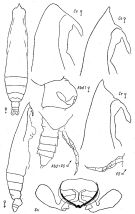 issued from : K.A. Brodsky, N.V. Vyshkvartzeva, M.S. Kos & E.L. Markhaseva in Opred Fauna SSSR, 1983, 135. [p.210, Fig.97]. Female & Male. Nota: Gn, complex genital; other figures from Fleminger, 1973. (redrawn)
|
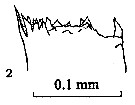 issued from : P.E. Lapernat & C. Razouls in Vie Milieu, 2002, 52 (1). [p.28, Pl. VI, fig.2]. As Pareucalanus ''attenuatus'' group.Masticatory edge of right Md gnathobase female (from off Malta, Mediterranean Sea). Nota: After Lapernat & Razouls (2002, p.19) the Itoh's index value = 570.6 (number of teeth: 9) on the right Md, and 688.5 on the left Md (number of teeth: 7).
|
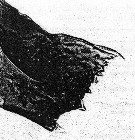 issued from : P.E. Lapernat & C. Razouls in Vie Milieu, 2002, 52 (1). [p.20, Pl. I, fig.1]. As Pareucalanus ''attenuatus'' group.
Masticatory edge of Md gnathobase female (from off Malta, Mediterranean Sea).
|
 issued from : Mulyadi in Published by Res. Center Biol., Indonesia Inst. Sci. Bogor, 2004. [p.116, Fig.66]. Female (from 07°29'S, 121°15'E): a, habitus (dorsal); b, forehead (lateral); c, last thoracic segment and urosome (lateral right side); d, A2; e, Md (palp); f, Mx1.
|
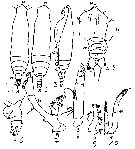 Issued from : M.C. Kos in Field guide for plankton. Zool Institute USSR Acad., Vol. I, 1972. As Eucalanus pseudoattenuatus. After Brodsky, 1962. Doubtfull. Female: 1, habitus (dorsal); 3, same (lateral); 4, forehead (ventral); 5, abdomen (dorsal), 6 same (lateral); 7, A2; 8, Md (palp); 9, Mx1. Male: 2, habitus (dorsal); 10, P5.
| | | | | Compl. Ref.: | | | Chen Y.-Q., 1986 (p.205, Table 1: abundance, %, with E. attenuatus s.l.); Suarez-Morales & Gasca, 1997 (p.1525); Alvarez-Cadena & al., 1998 (tab.3,4); Suarez-Morales, 1998 (p.345, Table 1); Suarez-Morales & Gasca, 1998 a (p.109); Suarez-Morales & al., 2000 (p.751, tab.1); Lopez-Salgado & al., 2000 (tab.1); Uysal & al., 2002 (p.17, tab.1); Hsiao & al., 2004 (p.325, tab.1); Pusch & al., 2004 (251, tab.3); Camisotti & al., 2005 (p.99); Alvarez-Silva & al., 2005 (p.39); Prusova & Smith, 2005 (p.76); Lopez-Ibarra & Palomares-Garcia, 2006 (p.63, Tabl. 1, seasonal abundance vs El-Niño); Jitlang & al., 2008 (p.65, Table 1); Neumann-Leitao & al., 2008 (p.799: Tab.II, fig.6); Lopez Ibarra, 2008 (p.1, Table 1, 2, figs.11: abundance); Miyashita & al., 2009 (p.815, Tabl.II); Hernandez-Trujillo & al., 2010 (p.913, Table 2); Cornils & al., 2010 (p.2076, Table 3); Schnack-Schiel & al., 2010 (p.2064, Table 2: E Atlantic subtropical/tropical); Dias & al., 2010 (p.230, Table 1); Medellin-Mora & Navas S., 2010 (p.265, Tab. 2); Uysal & Shmeleva, 2012 (p.909, Table I); Teuber & al., 2013 (p.28, Table 1, respiration rates); in CalCOFI regional list (MDO, Nov. 2013; M. Ohman, comm. pers.); Schukat & al., 2013 (p.1, Table 1, 2, fig.2, respiration, ingestion); Bonecker & a., 2014 (p.445, Table II as Paraeucalanus: frequency, horizontal & vertical distributions); Lopez-Ibarra & al., 2014 (p.453, Table 2, biogeographical affinity) ; Jerez-Guerrero & al., 2017 (p.1046, Table 1: temporal occurrence); Palomares-Garcia & al., 2018 (p.178, fig.3: relative frequency, Table 1); Acha & al., 2020 (p.1, Table 3: occurrence % vs ecoregions, as Paraeucalanus sewelli : lapsus calami). | | | | NZ: | 13 + 1 doubtful | | |
|
Distribution map of Pareucalanus sewelli by geographical zones
|
| | | | | | | | | | | |  issued from : A. Fleminger in Fishery Bull., 1973, 71 (4). [p.993, Fig.17]. As Eucalanus attenuatus. issued from : A. Fleminger in Fishery Bull., 1973, 71 (4). [p.993, Fig.17]. As Eucalanus attenuatus.
Geographical localities of the species in the attenuatus group. All identifications except those of Park (1968) and Bradford (1970) verified by examination of integumental organs. |
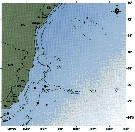 issued from : C. de O. Dias & A.V. Araujo in Atlas Zoopl. reg. central da Zona Econ. exclus. brasileira, S.L. Costa Bonecker (Edit), 2006, Série Livros 21. [p.45]. As paraeucalanus sewelli. issued from : C. de O. Dias & A.V. Araujo in Atlas Zoopl. reg. central da Zona Econ. exclus. brasileira, S.L. Costa Bonecker (Edit), 2006, Série Livros 21. [p.45]. As paraeucalanus sewelli.
Chart of occurrence in Brazilian waters (sampling between 22°-23° S).
Nota: sampling only 3 specimens. |
 Issued from : E. Goetze & M.D. Ohman in Deep-Sea Res. II, 2010, 57. [p.2123, Fig.12]. Issued from : E. Goetze & M.D. Ohman in Deep-Sea Res. II, 2010, 57. [p.2123, Fig.12].
Biogeographic distribution of Pareucalanus sewelli, a circumglobal species in subtropical-tropical waters.
This nominal species contains two distinct genetic lineages.
Solid and open circles mark sampling locations of specimens whose species identiry was verified to be P. sewelli (Atl/Ind) or P. sewelli (Pac), respectively, by DNA sequencing of 165 rRNA.
Fleminger (1973) records for P. sewelli s.l. are plotted as open squares. |
| | | | Loc: | | | South Africa (E) (off Durban, Natal), off Angola, Atlant. (equatorial), off S Cape Verde Is., Cape Verde Is., off Mauritania-NW Cape Verde Is., Great Meteor Seamount (off W Canary Is.), Uruguay (continental shelf), Brazil (S, off Rio de Janeiro, off Macaé, off Natal), Brazil current, Venezuela, Caribbean Colombia, Yucatan, G. of Mexico, Catibbean, Florida, Sargasso Sea, Station "S" (32°10'N, 64°30'W), New-York, Medit. ( W-E Basins as E. attenuatus), Arabian Sea, Indian, India (? Lawson's Bay), ? Madras, ? Kakinada Bay, Bay of Bengal, Indonesia-Malaysia, Flores Sea, SW Celebes, China Seas (South China Sea, in W. Zhang & al., 2010), Taiwan Strait, ? Taiwan (S, E), Japan, New Zealand, California, W Baja California (Bahia Magdalena), Gulf of California, La Paz, W Mexico, Zihuatanejo Bay, Costa Rica, Bahia Cupica (Colombia), Galapagos, off Chile | | | | N: | 510 ? | | | | Lg.: | | | (79) F: 6,1-3,89; M: 4,58-2,89; (131) F: 3,89-6,10; M: 2,89-4,58; ? (180) F: 3,6-5,15; M: 2,92-3,20; (196) F: 5,9-4,06; M: 3,6; ? (254) F: 4,3; ? (340) F: 3,65; (1023) F: 4,14; M: 2,97-3,20; (1122) F: 4,15; {F: 3,65-6,10; M: 2,89-4,58} | | | | Rem.: | epipelagic - ?. Overall Depth Range in Sargasso Sea: 0-2000 m.(Deevey & Brooks, 1977, Station "S"). For Acha & al. (2020) this species is observed on Northern shelfbreak in front of Rio de La Plata (Argentina).
See remarks in Eucalanus attenuatus, and on the doubts that subsist on certain identifications from the Indian Ocean and other place.
Uysal & al. (2002) confirm the presence of this species in the Mediterranean Sea.
According to Fleminger (1973, p.993), in relatively eutrophic regions of the Indo-Pacific, extending to the subtropical convergences, P. sewelli and P. attenuatus may co-occur and resemble one another in size and general morphology, but differences in integumental organs persist.
After T. Zuo & al. (2006) the body length is 3.75 mm; between 8 to 211 ind. m-2, present in 13 stations in the Yellow Sea-East China Sea, in autumn 2000. | | | Last update : 09/12/2020 | |
|
|
 Any use of this site for a publication will be mentioned with the following reference : Any use of this site for a publication will be mentioned with the following reference :
Razouls C., Desreumaux N., Kouwenberg J. and de Bovée F., 2005-2025. - Biodiversity of Marine Planktonic Copepods (morphology, geographical distribution and biological data). Sorbonne University, CNRS. Available at http://copepodes.obs-banyuls.fr/en [Accessed October 22, 2025] © copyright 2005-2025 Sorbonne University, CNRS
|
|
 |
 |



















